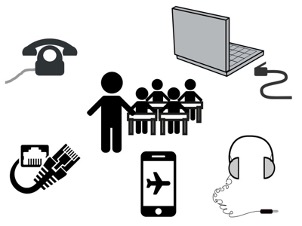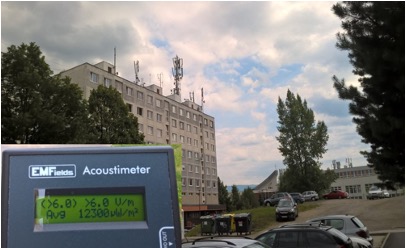Deeply worried by the health hazards caused by electromagnetic fields on the general public and especially on children, the European citizens' initiative "Stop (((5G))) – Stay Connected but Protected" calls for replacing wireless connections with cables in kindergartens, schools, hospitals, retirement homes, and all public buildings. We also call for educating the public on the potential adverse consequences on health associated with wireless connections; and how to minimise exposure.
We all plan a good future for our children, we want to give them the best possible education and we want them to use modern tools. But what does this mean in the light of the different opinions on the safety of exposure levels?
"Europeans for Safe Connections" is a coalition of national and international organisations that are aware of adverse consequences of the modern communication technologies. We emphasize that we are not against technology, but we advocate for safe technology and safe connections.
We believe that the introduction of mobile phones and then Wi-Fi and Bluetooth was a shot in the dark as it was not based on a thorough research of effects on common health and did not involve any extensive and thorough health monitoring program. Nowadays there are many studies that prove radiofrequency electromagnetic fields emitted by these technologies to be unsafe. Since even the latest fifth generation (5G) mobile data networks have not been tested on health and environmental impacts before being put on the market, we believe that the deployment of 5G constitutes an experiment on humanity and the environment.
In our ECI we address many other issues. In this article only one of them is discussed in the light of taking care for our children, ‘our most valuable possession’.
How it all began
Since the introduction of radio, the Earth is more and more exposed to artificial radiofrequency electromagnetic fields (RF EMF). Since the first use of radar in the 1950s, there have been concerns about how to prevent health problems caused by radar EMF exposure.
During the Cold War, the Western and Eastern blocks took a different approach in avoiding health risks of RF EMF.
In the Western bloc only the exposure limits for workers were set and these were based solely on thermal effects. (e.g. USA Bell Telephone Laboratories had 10,000 mW/m2 [1]).
The Eastern bloc had strict limits for workers and the general public, based on thermal as well as non-thermal biological effects. The limit for the general public was 10 mW/m2 for the radio frequency range of 0.3–300 GHz [2]. After 1989, the limit was increased to 50 mW/m2 in some Eastern countries [3].
In the EU, the maximum exposure limits for general public were accepted as late as in 1999 by Recommendation 1999/519/EC to 10,000 mW/m2 for frequencies 2–300 GHz. The maximum exposure limit for workers in the EU of 50,000 mW/m2 was accepted in 2004 and remained the same in the currently effective Directive 2013/35/EU.
When Central- and Eastern-European countries joined the EU, many of them accepted this convenient less limiting norm based on the false assumption that only thermal heating could be a health risk. This dogma has lead to selective science – only some of the studies were and still are taken into consideration by the private organisation ICNIRP which is the only organisation EU takes advice from.
Since then, many scientists showed a causal relationship between specific health problems and RF EMF at exposure levels below the limits and proposed new exposure guidelines. But today, worldwide known expert organisations in this field, other than ICNIRP, are still ignored, e.g.:
– BIOINITIATIVE claims no observable effect on humans under 0.001 mW/m2;
– The EUROPAEM EMF guideline sets the limit under 0.01 mW/m2;
– INSTITUT FÜR BAUBIOLOGIE claims that exposure of 0.01 – 1 mW/m2 is too high.
We believe that all this scientific data should be taken into consideration by EU.
Humans usually underestimate the risk of new discoveries, e.g. many chemical agents, antibiotics as well as X-ray radiation. Their exposure limits had been revised downwards with mounting scientific evidence. In the case of man-made non-ionizing RF EMF the exact opposite has happened and one can wonder why.
Is it safe?
Children of this generation are the first that might be exposed to wireless their whole lifetime. How can this compromise their health?
We Europeans for Safe Connections point out that RF EMFs have biological effects even at very low intensities and we ask for the application of the precautionary principle here.
A growing amount of scientific research links this wireless radiation to serious health effects — such as memory and sleep problems, headaches, cancer, and damage to brain development. The results of this research are publicly available to everyone. Below, a few sources are mentioned as examples of important findings.
The Journal of Epidemiology and Community Health is an international scientific journal. In December 2010, it published a study called "Cell phone use and behavioural problems in young children". Scientists observed more behavioural problems in children who had both prenatal and postnatal exposure to cell phones compared to children not exposed during either time period.
International Journal of Environmental Research and Public Health is an interdisciplinary, peer-reviewed, open access scientific journal. In November 2015, it published a study called "Association of Exposure to RF EMF with Glycated Haemoglobin and Risk of Type 2 Diabetes Mellitus". A team of scientists compared male students aged between 12 and 17 from a school with lower radiation (0.019 mW/m2) and a school with higher radiation (0.096 mW/m2). They found significantly higher glycated haemoglobin (a marker of high blood sugar) in the students exposed to higher RF EMF. Moreover, students exposed to higher RF EMF had a significantly higher risk of type 2 diabetes.
In December 2018, American journal of men's health published a study called "Mobile Phone Base Station Tower Settings Adjacent to School Buildings: Impact on Students' Cognitive Health" comparing male students aged between 13 and 16 from a school with lower radiation (20 mW/m2) to a school with higher radiation (100 mW/m2). Scientists found that school-aged adolescents exposed to higher levels of RF EMF exposure had delayed fine and gross motor skills, spatial working memory, and attention in comparison to those exposed to lower RF EMF levels.
Picture: Sorted list of RF EMF exposure values mentioned in this article
Credit: Creative Commons Attribution 4.0 International License
Source: author
Even South Africa National Report 2021 commissioned by the WHO International EMF Project confirms (in point 4) that RF EMF induces oxidative stress in cells, which can lead to mitochondrial DNA damage in cells and adverse effects on other biological processes and organs. Oxidative stress is generally recognised as a cause of many diseases.
Children and wireless
Children are exposed to various kinds of non-ionizing radiation in their daily life. They live in the surroundings of routers, antennas and all kind of wireless devices. After they are born, parents put baby monitors in their cradle. Later they wear wireless smartwatches, earbuds, use cell phones and tablets.
As people got more and more accustomed to cell phones, internet and wireless communication, the use of these tools also found gradually their way into school. At the end of 2019 it was almost impossible to find schools that don’t use Wi-Fi. Schools are a unique environment because children spend several hours a day in classrooms with strong wireless exposure.
On top of this, in 2019 – 2021 due to Covid 19 many EU countries closed schools and allowed only distance learning. That meant that many children spent hours at home with their tablets, notebooks or cell phones in a conference meetings with a teacher. Almost all of them were Wi-Fi connected.
To give an impression of the exposure of the children: According to calculations, 20 cm distance from a tablet with Wi-Fi means an exposure of 40.0 mW/m2 and 100 cm distance from a Wi-Fi router means an exposure of 8.0 mW/m2 [4]
Picture: Wireless in classroom. For more graphics visit:
https://ehtrust.org/wp-content/uploads/Wi-Fi-in-School-Worldwide-US-Final-92021-BlackWhite-2.pdf
Credit: Creative Commons Attribution 4.0 International License
Source: Author created
Children are not little adults
The EU Directive 2014/53/EU ensures that wireless devices are tested. However, the EN 50566:2017 and EN 50360:2017 standard reference the American standard IEC/IEEE 62209-1528 which does not take children into account, they are only based on proportions of "the adult male head as tabulated by the US Army".
The thickness of the skull acts as a barrier to radiation absorption. The skull of a child is much thinner than that of an adult so the absorption is higher.
The Electromagnetic Biology and Medicine journal publishes peer-reviewed research articles on the biological effects of non-ionizing electromagnetic fields (from extremely-low frequency to radiofrequency). In October 2011 a study published there on Exposure limits: the underestimation of absorbed cell phone radiation, especially in children found that "a child's head's absorption can be over two times greater, and absorption of the skull's bone marrow can be ten times greater than adults".
Environmental Research is a multi-disciplinary journal publishing high quality information. In November 2018 a study was published there focusing on Absorption of wireless radiation in the child versus adult brain and eye from cell phone conversation or virtual reality. This study "reveals that young eyes and brains absorb substantially higher local radiation doses than adults’".
Together with all the facts mentioned above and regarding the rapid rate of growth and development, children have to be seen as uniquely susceptible to the effects of radiation.
Picture: Operators systems on a residential block in Slovak republic.Current exposure 5 mW/m2.
Credit: Creative Commons Attribution 4.0 International License
Source: author
How do we suggest protecting our children?
Since children are obliged by law to attend school, it is important to create a safe environment for them. There are several leads to act on, to mention some options from our ECI:
- Cables should always be the first choice (instead of wireless).
- All wireless transmitters should be disabled on all Wi-Fi-enabled devices and school should provide wired network connections for desktop computers, laptops, notebooks, tablets, whiteboards and printers. Airplane mode should be used on cell phones.
- In general, wired local area network (LAN) should be provided for Internet access throughout the school.
- When no cabled solutions are possible, wireless should be time limited and the power should be set to the lowest usable level. After the work is finished, it must not be forgotten to turn off all wireless functions.
- Children should learn how to use their devices safely. By adult's example they would therefore also be indirectly educated.
- The school also should prohibit the use of cell phones and other personal electronic devices in instructional areas/classrooms.
Additional advantages to the lack of RF radiation of cabled solutions are: They are much more fault tolerant, more efficient in energy consumption and safer for long term usage. They allow a more secure data transmission and are not dependent on weather conditions (humidity) or obstacles in path (trees, walls).
Picture: Wired in classroom. For more graphics visit:
https://ehtrust.org/wp-content/uploads/Wi-Fi-in-School-Worldwide-US-Final-92021-BlackWhite-2.pdf
Credit: Creative Commons Attribution 4.0 International License
Source: Author created
Other ways to protect children
Not only inside the schools, but also on top of school buildings and near them there are sources of radiofrequency radiation: transmitters on the school roof and on nearby buildings or masts in the neighbourhood. These all are powerful sources of radiation.
Many scientists have written to school administrators stating that cell towers should not be located on or near schools.
Municipalities should make their own regulations and forbid cell towers nearby schools and kindergartens.
Parents should be interested and should demand better protection of their children.
Picture: Operators systems at the primary school and on a residential block in Slovak republic. Average exposure on the street is 12 mW/m2
Source: https://slovenskobez5g.org/wp-content/uploads/docs/Nepriaznivy_dopad_534_2007_1.pdf
Conclusion
There are many reasons to take protective measures for our children as they are longer and more heavily exposed during their lifetime, even in the period when they are physically more vulnerable than adults.
The EU citizens have not been asked whether they accept the pervasive health consequences from the wireless internet in the name of technological progress and digitalization.
Therefore in our ECI "Stop (((5G))) – Stay Connected but Protected" we are calling for stronger regulation to protect all life from radio frequency and microwave radiation.
In this article attention was given to proposals 6 and proposal 7 of our ECI.
"proposal 6: Replace wireless connections with cables. Do so immediately in places such as hospitals, kindergartens, schools, retirement homes, all public buildings"
"proposal 7: Educate the public on the hazards associated with wireless connections and how to minimize exposure (e.g. using cables)"
And we are not alone:
- France banned Wi-Fi in kindergartens in 2015 and restricts Wi-Fi in schools since 2018 by having the wireless off as the default setting and teachers use cables for Internet access. France also started educating the public years ago with public health initiatives about how to reduce exposure.
- Cyprus has removed Wi-Fi from elementary classrooms and has a strong public awareness campaign educating parents, teenagers, and pregnant women.
- The European Parliamentary Assembly issued Resolution 1815 in 2011 which recommends reducing EMF exposure to the public and recommends, in point 8.3.2.: "for children in general, and particularly in schools and classrooms, give preference to wired Internet connections, and strictly regulate the use of mobile phones by schoolchildren on school premises".
In point 8.1.1. it recommends : "all reasonable measures to reduce ... exposure to children and young people who seem to be most at risk from head tumours". - In several letters sent to school districts worldwide, physicians strongly recommended wired connections for technology in classrooms to eliminate unnecessary wireless radiation exposures.
References:
[1] Meahl, H. R.: Microwave radiation monitor, Electronics 32, 1959, pages 138 — 140
[2] Karel Marha, Jan Musil, Hana Tuhá: Elektromagnetické pole a životní prostředí, 1968
[3] e.g. in Czechoslovakia by Decree no. 408/1990
[4] Powed density S depends on many factors, this is an approximative calculation:
Source Power / (4 x π x distance2) = S
20 / (4 x 3,14 x 0,22) = 39,8 mW/m2 ≈ 40 000 µW/m2
100 / (4 x 3,14 x 12) = 7,0 mW/m2 ≈ 8 000 µW/m2
Contributors
Petra BertováPetra Bertová is a member of the team behind the European Citizens' Initiative (ECI) "Stop (((5G))) – Stay Connected but Protected"
Petra from Slovakia previously worked for an IT company and also in the education sector.
The opinions expressed on the ECI Forum reflect solely the point of view of their authors and can in no way be taken to reflect the position of the European Commission or of the European Union.









Leave a comment
Comments